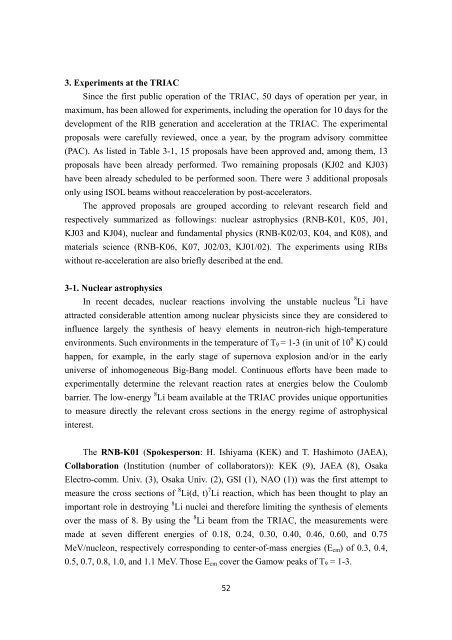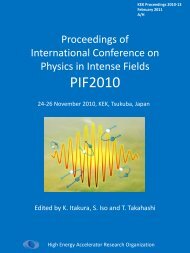TRIAC Progress Report - KEK
TRIAC Progress Report - KEK
TRIAC Progress Report - KEK
You also want an ePaper? Increase the reach of your titles
YUMPU automatically turns print PDFs into web optimized ePapers that Google loves.
3. Experiments at the <strong>TRIAC</strong><br />
Since the first public operation of the <strong>TRIAC</strong>, 50 days of operation per year, in<br />
maximum, has been allowed for experiments, including the operation for 10 days for the<br />
development of the RIB generation and acceleration at the <strong>TRIAC</strong>. The experimental<br />
proposals were carefully reviewed, once a year, by the program advisory committee<br />
(PAC). As listed in Table 3-1, 15 proposals have been approved and, among them, 13<br />
proposals have been already performed. Two remaining proposals (KJ02 and KJ03)<br />
have been already scheduled to be performed soon. There were 3 additional proposals<br />
only using ISOL beams without reacceleration by post-accelerators.<br />
The approved proposals are grouped according to relevant research field and<br />
respectively summarized as followings: nuclear astrophysics (RNB-K01, K05, J01,<br />
KJ03 and KJ04), nuclear and fundamental physics (RNB-K02/03, K04, and K08), and<br />
materials science (RNB-K06, K07, J02/03, KJ01/02). The experiments using RIBs<br />
without re-acceleration are also briefly described at the end.<br />
3-1. Nuclear astrophysics<br />
In recent decades, nuclear reactions involving the unstable nucleus 8 Li have<br />
attracted considerable attention among nuclear physicists since they are considered to<br />
influence largely the synthesis of heavy elements in neutron-rich high-temperature<br />
environments. Such environments in the temperature of T9 = 1-3 (in unit of 10 9 K) could<br />
happen, for example, in the early stage of supernova explosion and/or in the early<br />
universe of inhomogeneous Big-Bang model. Continuous efforts have been made to<br />
experimentally determine the relevant reaction rates at energies below the Coulomb<br />
barrier. The low-energy 8 Li beam available at the <strong>TRIAC</strong> provides unique opportunities<br />
to measure directly the relevant cross sections in the energy regime of astrophysical<br />
interest.<br />
The RNB-K01 (Spokesperson: H. Ishiyama (<strong>KEK</strong>) and T. Hashimoto (JAEA),<br />
Collaboration (Institution (number of collaborators)): <strong>KEK</strong> (9), JAEA (8), Osaka<br />
Electro-comm. Univ. (3), Osaka Univ. (2), GSI (1), NAO (1)) was the first attempt to<br />
measure the cross sections of 8 Li(d, t) 7 Li reaction, which has been thought to play an<br />
important role in destroying 8 Li nuclei and therefore limiting the synthesis of elements<br />
over the mass of 8. By using the 8 Li beam from the <strong>TRIAC</strong>, the measurements were<br />
made at seven different energies of 0.18, 0.24, 0.30, 0.40, 0.46, 0.60, and 0.75<br />
MeV/nucleon, respectively corresponding to center-of-mass energies (Ecm) of 0.3, 0.4,<br />
0.5, 0.7, 0.8, 1.0, and 1.1 MeV. Those Ecm cover the Gamow peaks of T9 = 1-3.<br />
52













